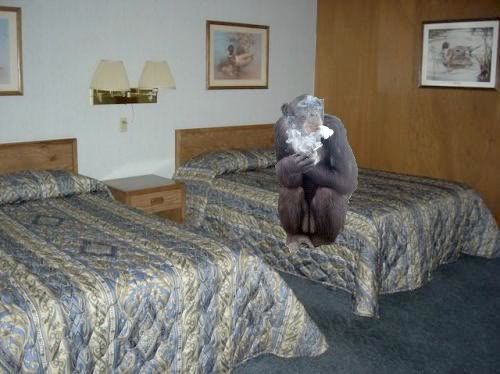Pictures of giant bears engraved on the walls of caves occupied by primitive people in Europe testify to the close association and struggle between man and bears for supremacy.
Despite its undisputed, all-powerful might, the big brown bear is mild and shy, seeking the solitude of its domain.
[The black bear] is essentially a forest dweller and versed in the art of climbing. Tree-climbing with the black bear is more of a stunt and prank than a necessity.
[The grizzly bear] is, by reason of its giant strength and courage, the king of beasts in western North America. The terrific impact from a lightning blow by one of its huge paws is sufficient to break the neck of a mighty bison and has earned for it the respect of both man and beast.
The grizzly is well aware of its great strength and knows how to use it to the best advantage. Despite its large size and lumbering gait, it is swift in action and can travel at the rate of a good horse.
The grizzly is basically a friendly creature in captivity. It will, in a playful gesture, probably break a man's arm or crush his back with a slap but it does not mean any harm; it does not realize the frailty of the human body.
Sometimes, when the anthropomorphism in this encyclopedia collides with the 1964 Audubon unified thesis that all plants and animals despise all other plants and animals, you get copy that reads like the first draft of Lord of the Rings.
At timberline on the highest mountains of North America, where the earthborn forest and the skyborn fury of the elements vie for control, every tree shows the violence of battle. Some crouch forward, hugging the rocks and the bleached trunks of their ancestors, others reel backward, their growing tips thrashing downward like corn tassels...Botanically these timberline trees differ in no way from the tall limber pine specimens of the valleys, in appearance they are a race apart - gnarled, dwarfed, and dedicated to fighting.
One might ask: why must our descriptions of nature be so burdened with notions of deliberate agency? Does this contrived narrative hinder, rather than enhance, the clarity of our understanding of the complex mechanisms that determine the form and function of our world?
Then, after you've finished giving your French poodle its latte enema, you might ask: what God-granted resolve must steel the hearts of those embattled old veterans the trees? If only we could hear the deep, thrumming metronome of their timeless battle hymn, perhaps Man, too, could take arms against that hoary old tyrant The Wind.
Trees have been successfully grown some distance north of the timberline, and evidence from pollen-preserving peat bogs there indicates that trees are marching northward into new terrain.
Where there are several types of trees in a front line, it is the spruces that are the advance scouts.
Pines...are the heavyweights of the fighting line.
The vertical depth of the timberline battlefield occasionally runs to 500 feet.
Normally the warfront is as jagged and toothed as the individual trees which maintain it.
When the battle rages, the thick, matted trees of timberline often give shelter to high-country birds, which seek their branches for protection.
In summer the mountain tops above timberline are gay with alpine flowers and bird notes. The wild, twisted trees, now in peaceful repose, show the ravages of a violence that has come and gone. But if you wish to visit them in winter when the wind is on the warpath, you may wonder how they have survived the wild tempests at timberline.
From the lonely sentinel on the lookout tower to the helicopter-flying smoke chasers, the Forest Service is prepared to take action at the first sign of trouble. With this aid, the Moose Creek arborvitaes should live for many more centuries, preserving for man a dignity and grace unsurpassed by any tree anywhere.
In our own country the "sanguinary" or red ant is the slave-maker. These little creatures (no more than three-eighths of an inch in length) sometimes attack the stronghold of ants much larger than themselves. More often, however, they victimize the shy little negro ant which is abundant throughout both North America and Europe.
Among mankind albinos occur much more frequently than many people realize. In fact, the word was coined to apply to white Negroes, these abnormalities usually being objects of superstitious veneration on the part of the African tribes. The legend of the "fair god" among the Indians of Middle America is as likely to have arisen because of the accident of an albino as from the visit of a native from the lost continent of Atlantis.
"Cleft lip occurs much more frequently than many people realize. In the time of the savage, witchdoctors shunned those with cleft lips as agents of disease. Science now corroborates this sentiment. The Navajo myth of "Canyon In Face" is as likely to have arisen because of the grotesque, embarrassing incidence of a cleft lip as from a visit by Space Gypsies."
Even if one stepped out into the night, there would be little to indicate the struggles for food taking place perhaps only a few feet away. Lacking the eyes and ears of the cat or owl, it seems impossible for most would-be observers to witness these dramatic episodes. Yet there are ways of finding out who these shy neighbors are, and even of ascertaining their activities. For example, it can be discerned that during the night a great-horned owl captured a weasel that had just eaten a field mouse caught while nibbling grass roots in the pasture. There are ways of learning something about the hundreds of other similar chain dinners devoured every night, with each participant in turn a prey for another, each fitting inside the one next larger, like a nest of children's blocks.
In attempting to describe the vertical stratification of a forest ecosystem, author "J.S." launches into a five-page-long metaphor about hotels. Any chance of this metaphor being useful is annihilated by J.S.'s editorializing about the transience and implied sexual caprice of the hotel's tenants. What emerges, instead of an informative chapter about forests, is something that sounds like thinly-veiled autobiography about the emotional emptiness of life as a permanent hotel resident.
Both a forest and a hotel have different layers or floors, with some individuals living on certain floors, and others moving from floor to floor.
The most familiar area of a hotel is the first floor or lobby. This is also the busiest place in the building, for here pass all those going to higher or lower floors. Visitors rest in the lobby, and convention delegates greet one another there. The lobby of the forest is the surface of the ground, with its tree-to-tree carpeting of leaf litter.
Unlike a tidy hotel, there are many animals under the carpet of leaf litter in a forest lobby.
Above the lobby in most hotels is a mezzanine. This is usually an incomplete floor and may be used only part of the year for conventions and the like. The herbaceous layer of the forest may be compared to the mezzanine.
As people are not expected to stay always on the same floor in a hotel, so one does not expect species and individuals of animals to be found always in the same layer of the forest.
The middle floors of a hotel seem to have considerable use. Plenty of rooms are available at a reasonable cost. In a forest small trees make up a definite understory.
Where one stays in a hotel depends on the number of rooms and how much they cost. Where animals live in the forest depends greatly on where their food is most abundant, but other factors are important.
If little is known about the upper floors of a hotel, even less is known about life up in the penthouse. Few persons are ever invited there and if one goes he usually does not stay long. The penthouse of the forest is the canopy.

Subscribe to:
Posts (Atom)







